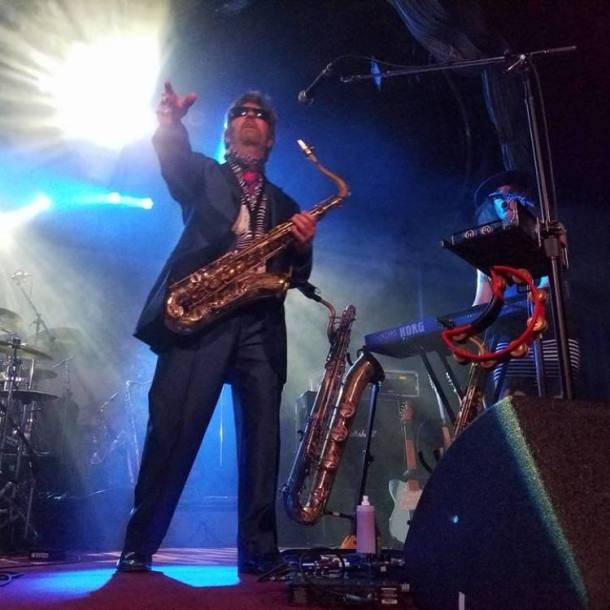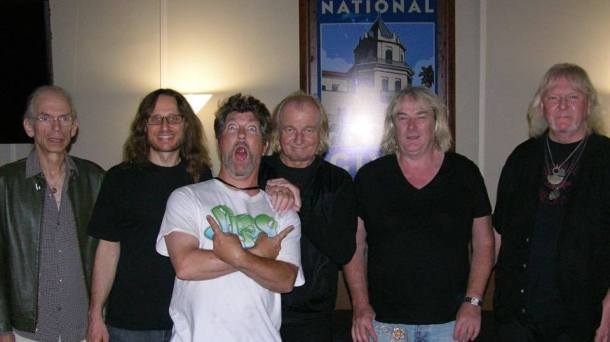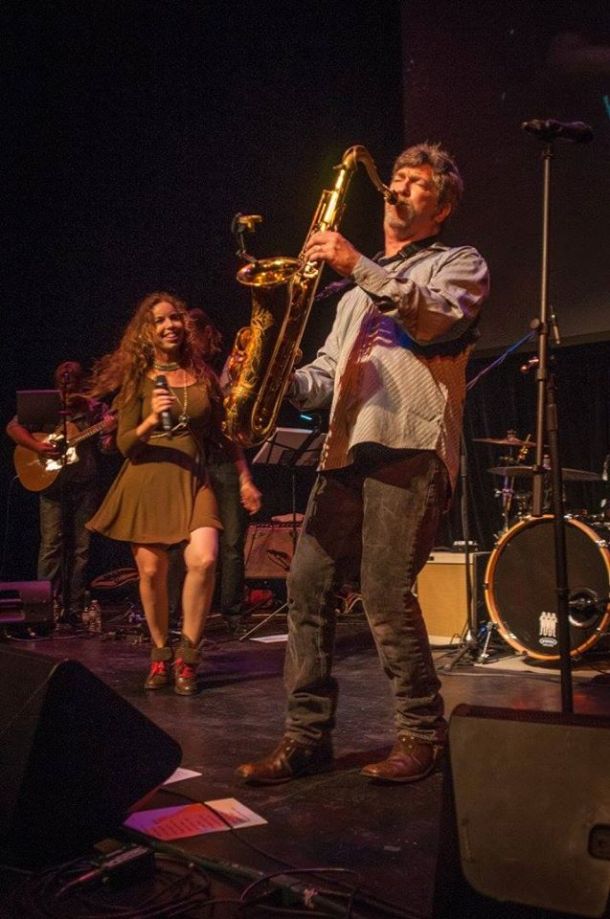
If you’ve been to a stateside prog rock festival in the last few years, chances are you’ve probably seen the amazing Jamison Smeltz on a stage somewhere. He is not just a prolific and very talented reed player- he’s a person who loves music, and that shows every time he graces the stage. He plays with a big smile and his musical passion is infectious.
I caught up with Jamison to talk to him about his musical background, his inspirations, as well as his plans for the future.
How did you first start playing music? Tell us a little bit about your musical background and education.
Piano lessons for 3 years starting at 6, then I played trumpet in school band from 4th- 8th grade, and switched to sax halfway through 8th grade. I took lessons from Bill Garton, a South Jersey school teacher and private instructor who went on to teach at University of the Arts in Philadelphia. I was All-State by 9th grade, and got into Stanford on a partial music scholarship. There I studied with Hal Stein and Stan Getz, and joined my first rock band called D*FeX, where I finally learned how to play ‘off the page,’ without reading charts (printed music).
After college I busked in Europe for a year, and went back to school to take my first real theory classes, which I did for a year. So besides three years of private lessons and one year of college level theory, I don’t have much by way of formal musical education.
Who were some of your saxophone heroes growing up, both in and out of the progressive world?
One of my method books was the Charlie Parker Omnibook, a compilation of Bird’s transcribed solos. I could always read very well, so to me these were as much etudes as they were a jazz vocabulary tool. They revealed to me the joy in the physical craft of playing the sax, as it relates your hands and fingers to the mechanics of your axe, especially dancing around the palm keys. Patterns and secrets are revealed. A sax in Bird’s hands was a tool of discovery, playfully sculpting genius melodies across slick bop changes, often his own original compositions.
I also copped the Phil Woods solo in “Just the Way You Are”, and Supertramp’s “Give a Little Bit”, but in general my ear was nowhere near good enough to play anything that wasn’t written out. I was also digging on Grover Washington Jr, whose playing is more modal and grooving, which is how my own style ended up. Of course the Floyd solos were epic, but I never tried to play along. The first pop sax records I tried to cop without a chart were from Songs from the Big Chair (Tears for Fears) and Will the Wolf Survive (Los Lobos).
You have a particular affection for the music of Yes. Tell us about your saxophone tribute to Yes. Why did you pick the songs that you did?
The Yes Tribute album came about as a result of the intersection between my work with the sax quartet medium, and my love of the band Yes’ music. I’ve worked with sax quartets for decades (New Renaissance Sax Quartet, Space Invaders, Berkeley Sax Quartet, Prima Volta Sax Quartet), and had a vision to arrange Yes for sax quartet (soprano, alto, tenor, baritone). I first did Turn of the Century (from Going for the One), and multitracked myself playing all four parts. I got Steve Howe a copy of that in 2001, and he responded positively so I decided to do an album. Two of the tracks are medleys. I just let the snake brain decide where to go. I finished the album in 2004 (SAXLIFE plays YES: TOTAL SAX RETAIN) and traveled to England and Scotland to see some shows and fanboy out.

You are also an educator. What are some of your go-to nuggets of wisdom for your students?
Ah, advice as an educator! Easy. 1: Persistence. The longer you do something, the better you get and the more fun it becomes. 2: All welcome. You are where you are, and you’ll get better. Do what you can. 3: Listen. 4: There is no I in Team, but there is Me. 5: You may not find your perfect instrument right away. 6: if you want to try to learn an instrument, give it a solid year of good effort. If it doesn’t work after that, good try, and try something else. 7: we can all do this. Everyone should be able to make music. 8: be kind to yourself, and respect each other. 9: what’s the worst that can happen? You play a wrong note, so what. Planes won’t fall from the sky. 10: join band, because there are boys/ girls in band. 11: you’ll get out of this what you put into it. 12: it always sounds terrible at the beginning. Laugh and keep going. 13: set a reasonable practice goal of 20 minutes, 3 days a week. More is better; anything is better than nothing. 14: Forget to practice this week? No biggie. You can’t get worse as a musician, only better; the more you play, the faster you get good.
Progressive rock has a history with the saxophone. Tell us about some of your favorite sax-playing proggers.
Most people, when they hear I’m a sax player, assume my big love is jazz. But nothing has ever tugged my heartstrings more than progressive rock, which combines all my loves: melody, harmony, counterpoint, extended song structures, intelligence and chops- and often improv also. I love Clarence Clemons’ tone and soul; John Helliwell’s playful joy; I love Dick Parry’s growl and bluster; Junior Walker’s swagger; Andy MacKay’s tone; Paul McCandless’ tone and technique. My Prog gods are Mel Collins and Ian MacDonald, those first Crimson albums laid the blueprint for prog sax. Sadly I don’t play flute, finally laying it to rest about 10 years ago after struggling with it for 20 years or so… Everyone tells me of David Jackson, but I’ve not explored VDGG and am mostly unfamiliar with his work. Two modern prog sax players who have my great respect are Rob Townsend and Theo Travis. My dream is to play with King Crimson one day, if Yes won’t have me. 

You’ve collaborated with many, many artists. Tell me about some of your favorite collaborations.
I’ve only recently seen the collaboration aspect of my career taking off, and that’s thanks in a large part to Cruise to the Edge and ProgStock and Progtoberfest. I’ve recorded on 2 Bad Dreams (Argentina) releases, one Glass Hammer cd, Fernando Perdomo’s Out to Sea 2, Peter McKibben, Petter Sandstrom of Moon Safari, Marcelo Paganini, 3 guys who met on the Cruise who go by Umae. I’ve played live with Matthias Olsen of Necromonkey and the fine fellows of Sonus Umbra, whose bassist Luis Nasser connected me with Mark Trueack of UPF. I sat in with Dave Kerzner Band on CTTE 17 and 18, and with them as well as District 97 at Progtoberfest ‘17.
But my fave collaboration story was that time a friend of a friend asked me to put some sax down on some re-worked Yes tunes Jon Anderson was putting together, “Long Distance Runaround” and “Then”. Jon never released them though, and I never got to talk with him about them. (I did invite him to see the Prince tribute I worked with for a bit when we played San Luis Obispo’s Jazz Fest, and he came!) Bottom line, I’ll play with anyone anytime. No fear! (That aforementioned Necromonkey set was all improvised.) I also work locally with many bands that don’t get beyond the Bay Area: Ten Ton Chicken, a jam/funk/Americana band I’ve been in for 20 years (and that I now play bass in), The CamelTones (Favorites from our Favorites, I’m on bass on this too), Pardon The Interruption (originals and tasty covers), The Fuxedos (Bay Area version), The Connell-Purves Group (weirdo jazz), a Bowie tribute called The Jean Genies, and a couple classical sax quartets. And I sub in the Golden Gate Park Band. And RIP miRthkon, one of my favorite experiences of all time.
Tell us about what you’re working on lately.
Recently, Pardon The Interruption put out 2 EPs, as did Hop Sauce (Meters-flavored instrumental funk). JoJo Razor asked me to play on her upcoming solo album, and my old pal Gary Worsham from D*FeX has a weird tune I’m gonna tackle this weekend. Ten Ton Chicken has about 3 full-length cds ready to mix from the last decade or so, but it’s not a priority of any of us so there we are. The last thing I did was a sax quartet of King’s X “We Were Born to be Loved” (I sang on it too) which I’ll probably post soon. (Facebook link HERE) I also did Weather Report’s Teen Town about a year ago.
I don’t have much patience for editing something to perfection; my strength has always been live performance. So I decided recently to record 2 passes on each horn, choose the best one, and be done with it. On ‘We Were Born’ I actually used both takes of each horn, smoothing out the mistakes and fattening up the sound. This is similar to how I work it with an offsite collaboration: as I usually don’t get too much by way of pre-production notes, I keep it visceral, do 3-4 passes of a song, and send it back for further instruction or advice. (Oddly, it always works pretty well.)
Who would be some of your dream collaborators?
I don’t think much of those ‘dream collaborations,’ but rather try and let it play out organically. But since you asked, I would very much love to work with: Yes, King Crimson, and Steve Hackett. Very excited to play live with UPF and perhaps record with them!
